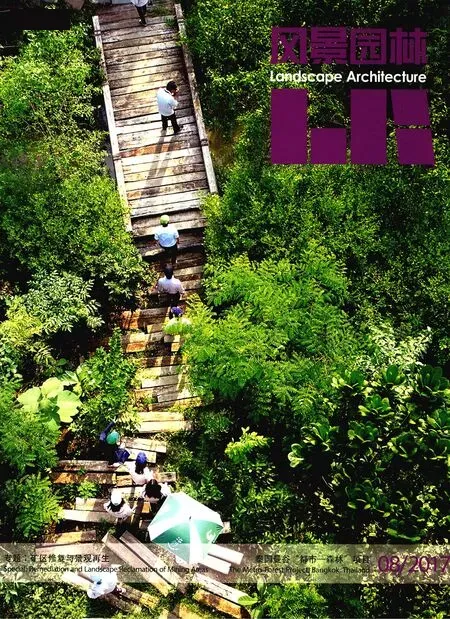矿区修复与景观再生
矿区修复与景观再生

人类文明的发展离不开对煤炭、金属与石材等矿产资源的开采,但也不可避免地对自然环境与社会生活造成各种干扰。中国是一个矿业大国,各类矿区及其废弃地已构成我国地表的常见组成要素,形成极其独特的地貌景观类型。
在人们的普遍印象中,矿区是一些破败荒凉、混乱不堪并充满危险的地方。然而当许多人亲眼目睹了峭壁嶙峋的矿石深坑、连绵高耸的尾矿料堆以及沧桑虬劲的机械构筑,内心却往往为之震撼——这些遭受破坏的土地形成了特殊的场地肌理,其显现出来的巨大空间尺度与孤寂荒凉气氛能够给人以强烈深沉的特殊感受,并蕴含着工业废墟、荒野自然甚至如画风景一般的丰富美学特性。也正基于此,诸如罗伯特·史密森(Robert Smithson)、罗伯特·莫里斯(Robert Morris)和赫尔曼·普瑞戈恩(Herman Prigann)等大地艺术家赋予废弃矿区以艺术内涵,而以彼得·拉茨(Peter Latz)为代表的一批风景园林师更是开启了新的后工业景观设计语汇。20世纪八九十年代以来,德国在鲁尔工业区和萨克森州褐煤矿区开展了大量工矿废弃地修复再生实践,并尝试通过举办建筑展、花园展以及大型公园项目有效改善自然环境,促进经济复兴与提升城市活力。诸如波鸿西园、盖尔森基兴市北星公园以及海尔布隆市砖瓦厂公园等经典作品都极大程度地尊重了采矿工业遗迹,并充分利用人为扰动的复杂地形创造出兼顾公众休闲、文化记忆与生态修复的后矿业景观。
其中,生态修复无疑是矿区景观重建最为重要的工作内容。依靠大自然极强的自愈能力,许多废弃矿区往往能逐渐恢复形成新的动植物群落系统,这在水热条件较好的地区尤为显著。例如将在广西南宁举办的第12届中国国际园林博览会园博园有意保留了近10处机制碎石矿场,将其改造为矿坑花园。其中面积最大的一处40m深坑自去年夏季停采以来,水位已快速上涨至接近地表位置,而周围几个废弃更久的采坑早已形成水草丰美、植被茂密的湖泊和灌草地。这些地处偏僻的宕口荒地长期无人问津,倒是成为野兔、蛙、蛇、蜥蜴与各类昆虫活跃的场所!
当然,并非所有矿区都如此欣欣向荣,更多的采矿废弃地依然面临着严重的环境污染和生态破坏:被剥离了表土的矿坑土地异常贫瘠,废石矿渣很容易形成水土流失,煤矸石山因酸性岩土条件寸草难生,冶炼剩余的尾矿更是对土壤水体造成各种重金属污染……当这些破坏和污染超过了土地所能承受的抗干扰极限,自然便无法自我恢复,如果不加人为干预就会持续恶化下去。正因如此,国内外的矿区修复实践都十分注重应用人工修复手段。在绿色环保产业蓬勃发展的今天,我国也已出现一大批生态修复企业。它们引进、研发并试验推广各种工程技术措施,涉及土壤改良、重金属治理、边坡复绿以及地灾防治等多个领域。人工修复通过物理、化学和生物等不同途径消除场地污染和重建生态系统,但同时也极大改变着矿区地貌景观形态,从而对许多有着潜在利用价值的景观资源和自然恢复的生境条件造成破坏。也因如此,目前过度人工干预的工程修复也受到生态学、遗产保护以及风景园林等专业的质疑……
伴随经济增速降低与城市化进程放缓,我国已出现越来越多的矿业废弃地,而如何重建健康的生态系统、拓展土地利用途径以及促进经济持续发展是我国目前矿区修复与景观再生面临的最大挑战。对此,人们或许需要对矿区土地建立更加全面深入的景观认知与价值判断,挖掘其丰富的文化与生态内涵;除了常规的建设开发与土地复垦之余,也要充分利用其独特的工业遗迹、风景体验以及栖息地条件创造出更大的综合效益。而这需要合理高效地兼顾自然恢复和人工修复措施,更需要组织起土地资源管理、城乡规划、风景园林、建筑、艺术以及遗产保护等众多专业人士群策群力!
近些年来,风景园林学科的研究和实践领域不断拓展——已经从单纯创造美学的第三自然走向保护、修复、转变与整合更为广泛的自然系统,而废弃矿区作为典型的第四类自然便是这一拓展的重要组成。本期专题“矿区修复与景观再生”希望能促进不同专业之间的沟通交流。不仅使我们学习更多的矿区修复理念与技术,从而与地质工程、环境科学、水土保持与生态保护等专业开展更加深入的合作,而且希望促使我们能够进一步思考风景园林学科的优势和劣势,以及我们能够为矿区修复与景观再生贡献怎样的智慧和力量。
立足现实,心怀梦想——面对着城市内外不断增加的受损自然与矿业土地,我们还有许多路要走……

本期专题组稿人:崔庆伟
2017年8月17日
Remediation and Landscape Reclamation of Mining Areas
The development of human civilization is inseparable from the coal, metal, stone and other mineral resources, but also inevitably causes various interference on the natural environment and social life. China is a mining power, and all types of mining areas and waste lands have become a common component of China’s surface,forming a very unique landscape type.
In people’s general impression, the mining area is somewhat a dilapidated, chaotic and dangerous place. However, when many people witness the cliffs of rugged ore pits, the towering tailing piles and the vicissitudes of mechanical constructions, their hearts are often shocked—these damaged lands form a special site texture, and their great spatial scales and the lonely desolate atmosphere can give people a strong and deep special feeling, and contains abundant aesthetic features of industrial ruins, wilderness nature and picturesque landscape. It is also based on this that the earth artists such as Robert Smithson, Robert Morris and Herman Prigann gave abandoned mining areas with artistic connotation,and a group of landscape architects represented by Peter Latz opened the new post-industrial landscape design vocabulary. Since the 1980s and 1990s, Germany has carried out a large number of industrial and industrial wasteland restoration and rehabilitation practices in the Ruhr Industrial Zone and the Saxon Lignite Mine Area. It has attempted to improve the natural environment and promote economic revitalization by organizing construction exhibitions, garden exhibitions and large park projects, to enhance the vitality of city. The classic works including the Customs Union, Bochum West Park, North Star Park in Gelsenkirchen City, and the Brick Factory Park in Haier Blooming City at a great degree respected the mining industry remains, made full use of the artificial disturbed complex terrain to create the post-mining landscape which took into account public leisure, cultural memory and ecological restoration.
Among them, the ecological restoration is undoubtedly the most important work in the mining area landscape reconstruction.Relying on the strong self-healing ability of the nature, many abandoned mining areas are often able to gradually restore into the new animal and plant community system. It is particularly good in areas where hydrothermal conditions are better. For example, the 12th China International Garden Expo Garden Park (to be held in Nanning, Guangxi), intends to retain nearly 10 mechanisms of gravel mine and transform it into a pit garden. In the 40m deep pit with the largest area, the water level has risen rapidly close to the surface position since the mining was stopped from last summer,while several nearby mining pits abandoned longer ago has long formed lakes and shrubs with lush vegetation. These remoted pits and caves are long abandoned, and have become active places for hares, frogs, snakes, lizards and various insects.
Of course, not all mining areas are so thriving, and many mining waste lands are still facing with serious environmental pollution and ecological damage: the pit land with the topsoil stripped is extremely poor, waste rock slag is easy to cause soil erosion,no grass can grow on coal gangue due to the acid geotechnical conditions, and the remaining tailings after melting cause a variety of heavy metal pollution to the soil and water… When these damage and pollution go beyond the anti-interference limit that the land can withstand, the nature cannot carry out self-recovery,and it will deteriorate without human intervention. Because of this,domestic and foreign mining area restoration practices are very focused on the application of arti fi cial repair means. In the present days with the vigorous development of the green industry, a large number of ecological restoration enterprises have also emerged in China. They introduce, develop, test and promote various engineering and technical measures, involving soil improvement,heavy metal control, slope greening, disaster prevention and control and other fields. The artificial restoration eliminates site pollution and reconstructs ecosystems through physical, chemical and biological pathways, but also greatly changes the landscape pattern of the mining area, resulting in damage to many habitat resources with potential use values and natural restoration. Because of this, the current status of excessively high arti fi cial intervention restoration project is also questioned by ecology, heritage protection, landscape architecture and other disciplines…
With the slowdown in economic growth and urbanization process, China has more and more mining waste lands. How to rebuild healthy ecosystems, expand land use, and promote sustainable economic development has became the current biggest problem for mining area restoration and landscape regeneration.In this regard, people may need to establish a more comprehensive landscape awareness and value judgment on the mining land, and tap its rich cultural and ecological connotation. In addition to the conventional construction and land reclamation, we should also make full use of the unique industrial heritage, scenic experience and habitat conditions, to create greater comprehensive benefits.And this requires a reasonable and efficient balance between natural recovery and arti fi cial restoration measures, and also need to organize land resources management, urban and rural planning,landscape architecture, architecture, art, heritage protection and many other professionals work together!
In recent years, the study and practice fields of landscape architecture research continue to expand—from the simple creation of the aesthetic third nature to the protection, repair,change and integration of the more extensive natural system, and the waste mining area as a typical fourth nature is an important component of this expansion. The theme topic of the current issue “Remediation and Landscape Reclamation of Mining Areas”is to promote the communication and exchange between different professions. It will not only help landscape architects to learn more ecological restoration ideas and technology, help them to carry out more in-depth cooperation with geological engineering,environmental science, soil and water conservation and ecological protection and other professions, but also hope that we can have indepth thinking of the disciplines’ own strengths and disadvantages,as well as what kind of wisdom and strength we can contribute to mining area restoration and landscape regeneration.
With our feet on the reality and dream in mind, in the face of the increasing damaged nature and mining land in and out of city,we still have a long way to go…
Translator: WANG Hui Proofreader: WANG Xi-yue
Acquiring editor of the current issue: CUI Qing-wei August 17th, 2017

